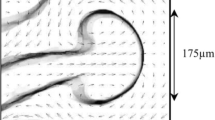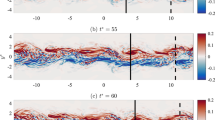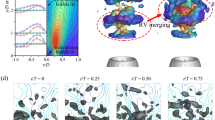Abstract
In this study, the life cycle of a vortex ring is visualized and simultaneously investigated in a three-dimensional (3D) domain and time resolved for an observer in a reference frame moving with the ring. By traversing the system, the object of interest is captured within the measurement volume during the entire cycle. The 4D (time-resolved 3D) data gained from the experiment are postprocessed by using modal analyses such as proper orthogonal decomposition and dynamic mode decomposition (DMD). The latter is used to reconstruct the vortex dynamics by means of the Q values, based on the most dominant modes in the DMD. These modal analyses allow reconstructing the dominant dynamics of the behavior of the secondary structures and their interaction with the vortex core. The visualization for the vortex ring at Re Γ = 5500 shows the well-known azimuthal instability and its growth at n = 6 in our experiments. As the process of transition further develops, we found a zig-zag-like mesh of tilted secondary structure and finally, helical coil-type vortex ribbons wrapped around the core, which emerge in the late-stage process. It is hypothesized that the initial state of this process is the emergence of a pair of standing helical waves both counterbalancing each other at the beginning and forming the zig-zag pattern. Azimuthal core flow is only weak in this phase. Later in the transition, one of the helical waves starts to take over the other and finally dominates. This results in the helical coil-type vortex structure seen in the reconstructed results, which goes with the increase in axial flow along the core. The hypothesis of coexisting helical waves is drawn from similarities in the transition of attached vortex rings in axisymmetric wakes.
Graphical abstract






















Similar content being viewed by others
References
Andrianne T, Norizham AR, Dimitriadis G (2011) Flow visualization and proper orthogonal decomposition of aeroelastic phenomena. In: Okamoto S (ed) Wind tunnels. http://hdl.handle.net/2268/73232
Archer PJ, Thomas TG, Coleman GN (2008) Direct numerical simulation of vortex ring evolution from the laminar to the early turbulent regime. J Fluid Mech 598:201–226
Bagheri S (2010) Analysis and control of transitional shear flows using global modes. Stockholm
Bergdorf M, Koumoutsakos P, Leonard A (2007) Direct numerical simulation of vortex rings at Re γ = 7500. J Fluid Mech 581:495–505
Berkooz G, Holmes P, Lumley JL (1993) The proper orthogonal decomposition in the analysis of turbulent flows. Ann Rev Fluid Mech 25:539–575. doi:10.1146/annurev.fl.25.010193.002543
Brücker C (1997) 3D scanning PIV applied to an air flow in a motored engine using digital high-speed video. Meas Sci Technol 8:1480–1492
Brücker C (2001) Spatio-temporal reconstruction of vortex dynamics in axi-symmetric wakes. J Fluid Struct 15:543
Chen KK, Tu JH, Rowley CW (2012) Variants of dynamic mode decomposition: boundary conditions, Koopman, and Fourier analyses. J Nonlinear Sci 22:887–915. doi:10.1007/s00332-012-9130-9
Gan L, Nickels TB, Dawson JR (2011) An experimental study of a turbulent vortex ring: a three-dimensional representation. Exp Fluids 51:1493–1507. doi:10.1007/s00348-011-1156-5
Haller G, Sapsis T (2011) Lagrangian coherent structures and the smallest finite-time Lyapunov exponent. Chaos 21:023115
Hunt JCR, Wray A, Moin P (1988) Eddies, stream, and convergence zones in turbulent flows. Center for Turbulence Research Report CTR-S88
Jovanovi MR, Schmid PJ, Nichols JW (2014) Sparsity-promoting dynamic mode decomposition. Phys Fluids 26:024103
Kitzhofer J, Nonn T, Brücker C (2013) Generation and visualization of volumetric PIV data fields. Exp Fluids 51:1471–1492. doi:10.1007/s00348-011-1176-1
Maxworthy T (1977) Some experimental studies of vortex rings. J Fluid Mech 81:465–495
Naitoh T, Fukuda N, Gotoh T, Yamada H, Nakajima K (2002) Experimental study of axial flow in a vortex ring. Phys Fluids 14(1):143–149
Ponitz B, Sastuba M, Brücker C, Kitzhofer J (2012) Volumetric velocimetry via scanning back-projection and least-squares-matching algorithms of a vortex ring. 16th International symposium on applications of laser techniques to fluid mechanics. ISBN: 978-989-98777-5-7
Rowley CW, Mezic I, Bagheri S et al (2009) Spectral analysis of nonlinear flows. J Fluid Mech 641:115–127
Saffman P (1970) The velocity of viscous vortex rings. Stud Appl Maths 49:371–380
Schmid PJ (2010) Dynamic Mode Decomposition of numerical and experimental data. J Fluid Mech 656:5–28
Schmid PJ, Violato D, Scarano F (2012) Decomposition of time-resolved tomographic PIV. Exp Fluids 52:1567–1579
Shariff K, Verzicco R, Orlandi P (1994) A numerical study of 3-D vortex ring instabilities: viscous corrections and early nonlinear stage. J Fluid Mech 279:351–375
Tu JH, Rowley CW (2012) An improved algorithm for balanced POD through an analytic treatment of impulse response tails. J Comput Phys 231:5317–5333. doi:10.1016/j.jcp.2012.04.023
Tu JH, Rowley CW, Luchtenburg DM (2013) On dynamic mode decomposition: theory and applications. J Comput Dyn. arXiv:1312.0041
Widnall SE, Sullivan JP (1973) On the stability of vortex rings. Proc R Soc Lond A 332:335–353
Acknowledgments
The modal analyses using DMD is based upon work supported by the Air Force Office of Scientific Research, the Air Force Material Command, the USAF under Award No. FA9550-14-1-0315, and the program manager Gregg Abate.
Author information
Authors and Affiliations
Corresponding author
Electronic supplementary material
Below is the link to the electronic supplementary material.
Vortex ring life cycle animation: Visualization by reconstructed particle distribution and evaluated vortex core (red and blue iso-contours) within the SBP domain 1 (MPG 16688 kb)
Vortex ring life cycle animation: Visualization by dye flow tracing of the symmetrical axis of the vortex ring 2 (MPG 9772 kb)
Vortex ring life cycle animation: Visualization by iso-surfaces of the vorticity components ω θ × D/U trav (black colored, iso-value = −10.5) and ω z × D/U trav (yellow and red colored, iso-value = ±4.1) and the velocity in z-direction v z /U trav (blue colored, iso-value = −1.4) 3 (MPG 8612 kb)
Appendix
Appendix
1.1 Part A: measurement domain cut off
The measurement domain cut off as documented in Fig. 4 and seen in Fig. 8 is throughout the results of this paper. It is a consequence of the loss of velocity information at the borders of the domain due to the larger search cuboids in the LSM software package used (Dynamic Studio V4.1). At the time of processing this problem could not be solved. For calculation of the mean values, grid nodes were only considered where azimuthal vorticity is of considerable magnitude. Note that the vortex core region is to 80 % inside the box, see Fig. 11. For the modal analyses, the truncated part of the vortex ring might affect the higher modes. However, POD modes shown herein are limited to a maximum of mode #3 and the highest mode used for sparsity-promoting DMD is 15 out of a total of 400. In addition, the 2D POD is mostly used for the cylindrical surface at a radius of 14 mm which is completely covered by the data in the measurement box.
1.2 Part B: proper orthogonal decomposition analysis (POD)
POD is one common method to perform a modal reduction of a snapshot series of observables (e.g., velocity field). For more information, the reader is referred to Berkooz et al. (1993) and Andrianne et al. (2011). In fluid dynamics, POD is used to extract dominant flow characteristics by identifying spatial structures based on their statistical occurrences.
The applied POD-algorithm results in orthogonal structures (Topos or POD-Modes) and their temporal behavior (Chronos, temporal POD-coefficients or weighting factors). Thus, a snapshot can be reconstructed by summing the mean flow field and all modes multiplied by the coefficient of the particular snapshot. Let
be a vector of observables (e.g., velocity components) with M directions at a specific time step j.
All snapshots of the time series are stacked such that follows
The mean flow field
is subtracted from each snapshot to achieve a time series of fluctuations
on which the decomposition is applied. Therefore, the covariance matrix C is calculated using the following equation
The eigendecomposition of \(C\) leads to the eigenvectors \(\mu\) and eigenvalues \(\lambda\).
In the decomposition process, the eigenvectors \(\mu\) are used to calculate the orthogonal modes as follows
The eigenvalues \(\lambda\) characterize the energy spectrum of the fluctuations. In order to perform a recalculation of the original data field, each of the POD-modes must be multiplied by a temporal coefficient \(a(t)\). These coefficients \(a(t)\) are generated by projecting each orthogonal structure (POD-mode) onto each snapshot of the original data field. A memory efficient variant—which does not rely on the calculation of the POD-modes—is presented in the following expression:
The following equation demonstrates the whole recalculation process
The resulting modes of the POD analysis are used to identify the most energetic flow structures and to distinguish the different phases of the transition from laminar state to turbulent breakdown.
1.3 Part C: dynamic mode decomposition analysis (DMD)
DMD is a novel data-processing technique from fluid dynamics, which was introduced by Schmid (2010). It presents a modal decomposition for nonlinear flows and features the extraction of coherent structures with a single frequency and growth/decay rate. However, these data stem from a nonlinear process: the DMD computes a linear model, which then approximates the underlying dynamics. An equidistant snapshot sequence N + 1 of an observable (measuring data) \(x = \left( {u_{1} , \cdots ,u_{M} } \right)^{T} \in {\mathbb{C}}^{M \times 1}\) is stacked into two matrices: \(K_{1} \triangleq \left[ {x_{0} , \ldots ,x_{N - 1} } \right] \in {\mathbb{C}}^{M \times N}\) and \(K_{2} \triangleq \left[ {x_{1} , \ldots ,x_{N} } \right] \in {\mathbb{C}}^{M \times N}\). The matrices \(K_{1}\) and \(K_{2}\) are shifted by one time step \(\varDelta t\) and can be linked via the mapping matrix (system matrix) \(A \in {\mathbb{C}}^{M \times M}\) such that \(K_{2} = AK_{1} = K_{1} S\). Since the above data stem from experiments, the system matrix A is unknown. For a very large system, it is computationally impossible to solve the eigenvalue problem directly as well as fulfilling the storage demand (Bagheri 2010). The idea is to solve an approximate eigenvalue problem by projecting A onto an N-dimensional Krylov subspace and to compute the eigenvalues and eigenvectors of the resulting low-rank operator (Rowley et al. 2009). One type of Krylov method is the Arnoldi algorithm, and the knowledge of A is not required for the following variant:
The final snapshot \(x_{N}\) can be expressed as a linear combination of the previous ones \(\left[ {x_{0} , \ldots ,x_{N - 1} } \right]\) by computing the weighting factors \(\left[ {a_{0} , \ldots ,a_{N - 1} } \right]\)- considering that the residual r is minimized (least-squares problem)—to form the companion matrix
In Schmid (2010), the author describes a more robust solution, which is achieved by applying a singular value decomposition (SVD) on \(K_{1}\) such that \(K_{1} = U\varSigma W^{*}\). The full-rank matrix \(\tilde{S} \in {\mathbb{C}}^{N \times N}\) is determined on the subspace spanned by the orthogonal basis vectors \(U\) (POD modes) of \(K_{1}\), described by the following equation \(\tilde{S} = U^{ * } K_{2} W\varSigma^{ - 1}\). Solving the eigenvalue problem \(\tilde{S}\mu = \lambda \mu\) leads to a subset of complex eigenvectors \(\mu\). The DMD modes are defined by \(\varPhi = U\mu\), which implies a mapping of the eigenvectors form lower \(\mu \in {\mathbb{C}}^{N \times N}\) to higher \(\varPhi \in {\mathbb{C}}^{M \times N}\) dimensional space. The complex eigenvalues \(\lambda\) contain growth/decay rates \(\delta = {{\Re \left[ {\log \left( \lambda \right)} \right]} \mathord{\left/ {\vphantom {{\Re \left[ {\log \left( \lambda \right)} \right]} \varDelta }} \right. \kern-0pt} \varDelta }t\) and frequencies \(f = {{\Im \left[ {\log \left( \lambda \right)} \right]} \mathord{\left/ {\vphantom {{\Im \left[ {\log \left( \lambda \right)} \right]} {\left( {2\pi \varDelta t} \right)}}} \right. \kern-0pt} {\left( {2\pi \varDelta t} \right)}}\) of the corresponding DMD modes \(\varPhi\). The temporal behavior of the DMD modes is contained in the Vandermonde matrix \(V_{and}\), which is expressed as
The DMD modes \(\varPhi\) must be scaled in order to perform a data recalculation of the first snapshot sequence \(K_{1} = \varPhi D_{\alpha } V_{\text{and}}\). Therefore, having a look into \(V_{\text{and}}\) shows, that the first snapshot \(x_{0}\) is independent from temporal behavior since \(\lambda = \left[ {\lambda_{1}^{0} , \ldots ,\lambda_{N}^{0} } \right] = 1\). The scaling factors \(\alpha = \left[ {\alpha_{1} \cdots \alpha_{N} } \right]^{T}\) (amplitudes) are calculated such that \(\varPhi D_{\alpha } = x_{0}\), where \(D_{\alpha } = {\text{diag}}\left\{ {\left. \alpha \right\}} \right.\).
Detailed descriptions about the different variants of the calculation of DMD-modes combined with the basic theories are presented in Tu et al. (2013).
1.3.1 Sparsity-promoting DMD
A new solution to find the scaling vector \(\alpha\) was introduced in Jovanovi et al. (2014). Here, the scaling vector \(\alpha\) is obtained by considering the temporal growth/decay rates of the DMD modes in order to approximate the entire data sequence \(K_{1}\) optimally. Therefore, the problem can be expressed as
This expression is a convex optimization problem which can be formed into
where \(P = \left( {\mu^{*} \mu } \right) \circ \left( {\overline{{V_{\text{and}} V_{\text{and}}^{ *} }} } \right)\), \(q = \overline{{{\text{diag}}\left( {V_{\text{and}} W\sum^{*} \mu } \right)}}\) and \(s = {\text{trace}}\left( {\sum^{*} \sum } \right)\).
Its solution leads to the following equation:\(\alpha = P^{ - 1} q = \left( {\left( {\mu^{*} \mu } \right) \circ \left( {\overline{{V_{\text{and}} V_{\text{and}}^{ *} }} } \right)} \right)^{ - 1} \overline{{{\text{diag}}\left( {V_{\text{and}} W\varSigma^{*} \mu } \right)}}\).
Please note that the overbar signifies the complex–conjugate of a vector/matrix, * indicates the complex–conjugate-transpose and \(\circ\) denotes the element-wise multiplication. For a very detailed step-by-step description, the reader is referred to Jovanovi et al. (2014).
The key challenge is to identify a subset of DMD modes that captures the most important dynamic structures in order to achieve a good high-quality approximation of the real process. To solve this problem, sparsity-promoting DMD was developed. The user defines a threshold between a number of extracted DMD modes and approximation quality. The sparsity structure of the vector of amplitudes \(\alpha\) is fixed in order to determine the optimal values of the non-zero amplitudes. Therefore, the objective function \(J\left( \alpha \right)\) is extended with an additional term such that
\(\mathop {\hbox{min} \, }\nolimits_{\alpha } J\left( \alpha \right) + \gamma \sum\nolimits_{i = 1}^{N} {\left| {\alpha_{i} } \right|}\), where \(\gamma\) denotes a regularization parameter that dictates the sparsity of the vector \(\alpha\).
Rights and permissions
About this article
Cite this article
Ponitz, B., Sastuba, M. & Brücker, C. 4D visualization study of a vortex ring life cycle using modal analyses. J Vis 19, 237–259 (2016). https://doi.org/10.1007/s12650-015-0314-x
Received:
Revised:
Accepted:
Published:
Issue Date:
DOI: https://doi.org/10.1007/s12650-015-0314-x




